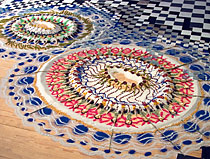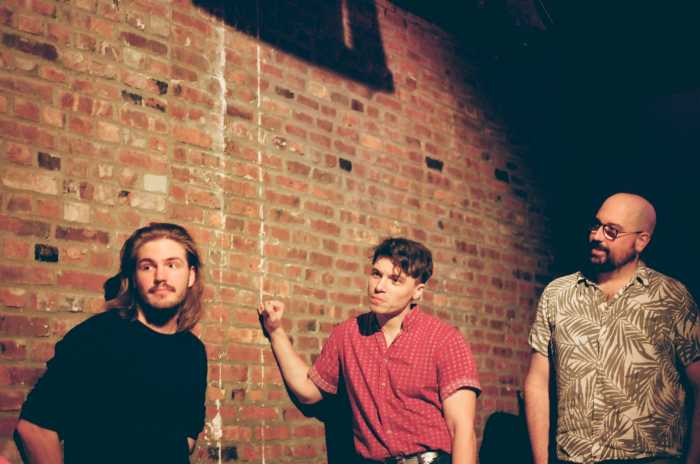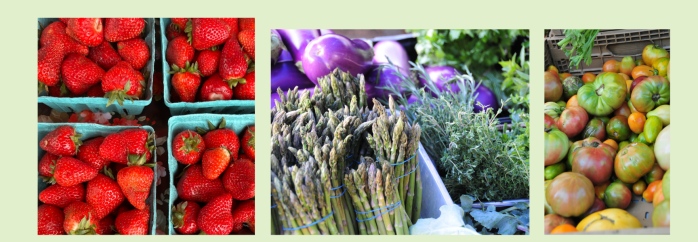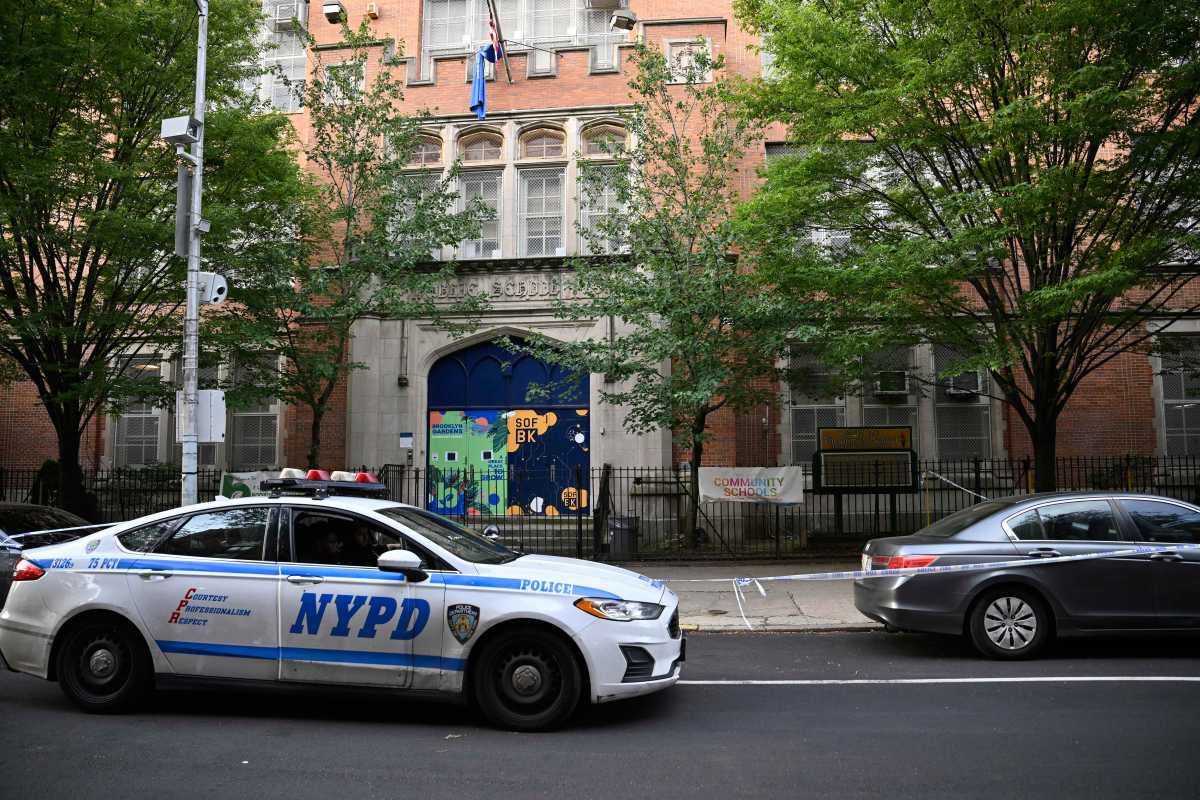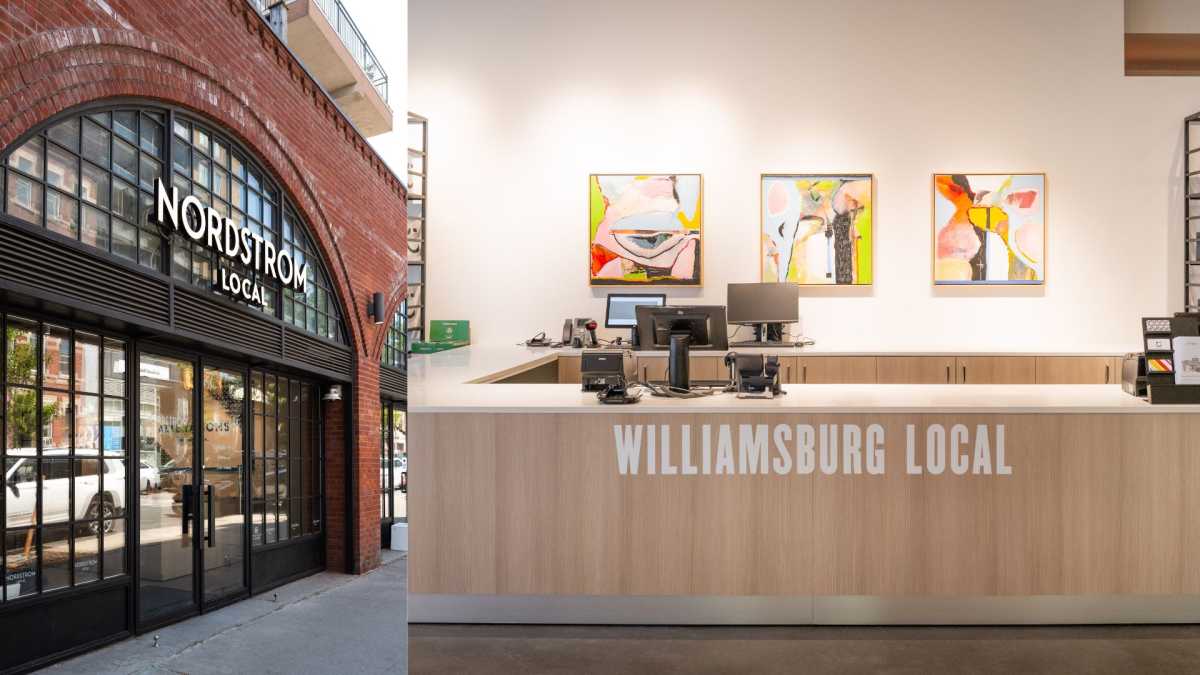The mandalas spread out in rippling waves
of color from a series of sandy footprints leading across the
gallery floor. Brightly hued spices, accented by almonds, flowers,
dried fruits and carefully placed mounds of tiny peas, swirl
in oval patterns. Each footprint is comprised entirely of commodities
culled from the local Brooklyn community.
San Francisco artist Joe Mangrum, 37, spent a week gathering
materials in the borough that he found visually exciting and
meaningful to create the installation, "Impressions,"
at Ch’i Contemporary Fine Art in Williamsburg.
On display through April 17, "Impressions" is a visceral
and visionary response to New York City, according to Mangrum.
The installation depicts the conflict between Nature and the
industrial, man-made world, and also between the individual and
an oppressive, socialized environment.
The rainbow ripples made of soft, organic stuff appear fragile,
but they are realized as powerful, irresistible forces that can
rip up geometrically laid out tiles and buckle pavements. The
dramatic narrative, in which forces of Nature arise to hurl off
the yoke of societal control, is a central theme of Mangrum’s
work.
The large color photos documenting his previous installation
work that fill out Ch’i’s gallery space are a recent innovation.
For many years, Mangrum says, it was a struggle to get decent
photographs of the performance-like works. It’s extraordinary
that such an artist has survived and thrived, creating playful,
Zen moments of public interaction and visual contemplation.
And yet, recognition came early and easily for Mangrum. Maybe
it’s because there’s an inclusiveness to the work that transcends
the usual categories of art consumption. Pedestrians of all ages
pause, peer though the window, and then wander into Ch’i. They
step gingerly around the little swirls of lentils and puddles
of colored sand, pointing and talking happily.
A prodigy who started painting at age 8, Mangrum graduated from
the School at the Art Institute of Chicago in 1991 and then set
out to see the world. While following the Beastie Boys’ tour,
he learned sand painting techniques from a group of Tibetan monks.
In 1994 he began creating daily installations at Laguna Beach,
making what he terms an "environmental statement" against
the construction of a toll road that was destroying public parklands.
"Every morning I’d walk for two hours and gather flowers
and plant materials, and then create all day," Mangrum told
GO Brooklyn. The creative process he describes as a "12-hour
meditation of peeling apart flowers to a stem/petal/pistil level
… deconstructing and then laying them out in symmetrical forms."
The 16- to 20-foot-wide mandalas, which were swept away by park
attendants each morning, attracted a good deal of attention from
park visitors. After one week, a front-page story in the Los
Angeles Times made Mangrum a celebrity.
Mangrum seems as surprised as he is delighted by the response
to his work. But he has an explanation: the mandala symbol, he
says, has "the abilityto communicate to all cultures, without
a linguistic barrier."
While Mangrum’s work piqued the interest of the media and local
residents, the San Joaquin Hills Toll Road was completed in 1994.
Before long, Mangrum began incorporating industrial and mechanistic
structures into his works, underscoring the significance of the
organic materials and forms. In one piece, "Trans-Mission
98," he deconstructed his broken-down car, cutting it into
tiny pieces, which then became a Lilliputian city in a San Francisco
plaza. With the help of passersby, a truckload of living sod
was used to create tendrils of greenery engulfing the metallic
structure. (A photograph of this installation is on view at Ch’i.)
In another piece, "Detonation Earth," marking the 60th
anniversary of the bombing of Hiroshima and Nagasaki, Mangrum
and 20 volunteers created a floating mushroom cloud composed
of hundreds of pounds of sprouted wheatgrass and draped it over
a reproduction of the Nike of Samothrace in chains. A photograph
shows the grid-like miniature landscape of computer parts, industrial
scraps and bottled compost that surrounded the statue.
Employing edible materials such as fruit, nuts, seeds, wheatgrass,
milk and honey, Mangrum seeks to impart a living presence to
his works. There are fragrances, and textures that one yearns
to touch; in addition, the materials begin changing from the
moment they are added to the assemblages. Vulnerable to destruction
by time, accident or intent, the pieces are both miraculous manifestations
and wry commentaries on society. Made of uneaten food, sprockets
and whatever else is handy, the sculptures seem to be generated
in the imagination of a child.
Although Mangrum won the Lorenzo De Medici Award at the Florence
Biennale in 2003, conversing with him doesn’t feel like an interview
with an "important" American artist. His unpretentious
words emphasize ephemeral moments in human lives, transformed
by unexpected encounters with art.
When asked if anyone has ever eaten part of his sculptures, Mangrum
says laughingly, "I have!"
Visitors to Ch’i behave as though they had helped to create these
designs themselves; or as if they were in the presence of something
sacred.
There’s a kernel of truth in both of these notions. Mangrum’s
work was born on the streets, made holy by its capacity to involve
the public in the process of art. And after it’s all been swept
away, what was precious about it was the moment of shared wonder
it inspired.
"Impressions," an installation,
and a show of photographs by Joe Mangrum, is on view through
April 17 at Ch’i Contemporary Fine Art, 293 Grand St. at Havemeyer
Street in Williamsburg. For more information, call (718) 218-8939
or visit www.qianartspace.com.


